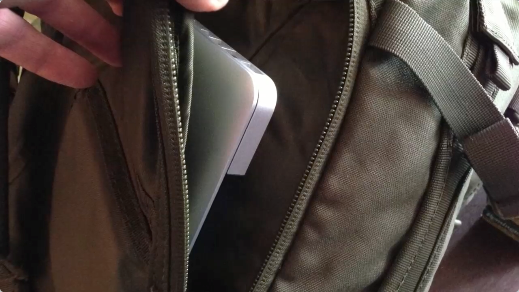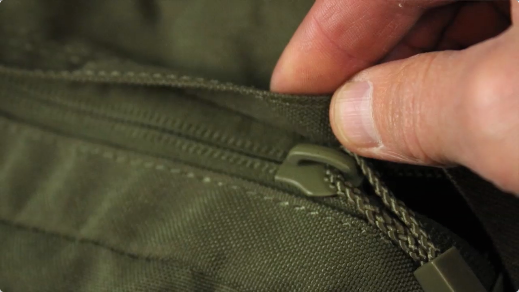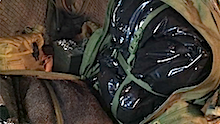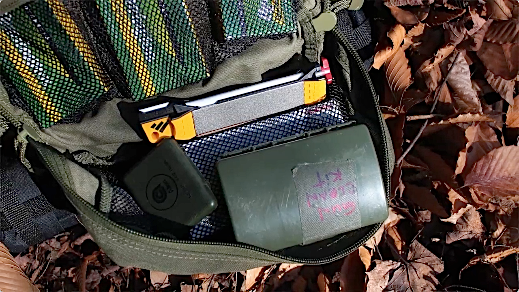Let’s look at the Condor 3-Day Assault Pack to get our bearings on what to look for in a 72-Hour BOB, Bug-Out Bag/Pack and see if this backpack is one of the best bags for a bug-out, emergency, survival or disaster pack. So... The Condor 3-Day Assault Pack is a pretty large 3038 cubic inch or 50 liter internal frame pack, with 7 generous compartments and a ton of pockets, pouches and tie downs to keep things organized... and it’s sized really well for a 72 Hour Bug-Out Bag. This pack is made out of 1000-Denier, water and wear-resistant nylon - which is regarded as one of the most rugged backpack shell materials. The Assault Pack comes in several colors... but of course because I’m old-school practical, and believe a Bug-Out Bag should blend in, not stand out, I got OD green, but this pack also comes in Black, Tan, ACU, A-TACS and Multicam.

Lets Talk About the Shoulder Straps... Since comfort is key when selecting a pack that COULD be strapped on your back for days, and maybe weeks, let’s talk about the support system for this pack starting with the straps... At their widest point, the shoulder straps are about 3 1/2 inches or 8 1/4 centimeters wide and the padding is nearly 3/4 of an inch or 1.8 centimeters thick. These straps are not likely to cut into your shoulders. The front of the straps are designed with a multitude of gear-carrying options including: horizontal clip-on straps, D Rings and vertical MOLLE webbing.
For me, I just found the horizontal straps to be a convenient and secure way to clip on some essentials like my Spotlight Tactical LED, a can of pepper spray and my Gerber Combat Folder... although in a bug-out, I may NOT have any valuables or weapons showing on the outside of my pack.
The Sternum Strap As the shoulder straps begin to taper and contour, there is a chest or sternum strap. The sternum strap helps prevent your shoulders from being pulled back from the pack weight, while also keeping the shoulder straps from shifting around and generally helping keep the pack load distributed properly. I really like that the sternum strap is adjustable both up and down AND side to side to match a wide variety of body sizes. Now the shoulder strap terminates toward the base of the pack and adjusts easily for large and small bodies by pulling or loosening a strap.
Something Cool... All of the external straps on this pack end with a Velcro loop system. This makes it easy to roll up and secure each strap end so that they’re not flapping around, getting in your way and catching on things in the woods. I have often cut long pack straps, but I like not having to... just in case I put on a few too many pounds someday or take up body building again... which is not likely at this point.
Next, on the back of the pack there’s about a quarter inch of padding and on top of this padding you will see 4 strategically placed padded areas that are raised nearly 3/8s of an inch or about 9.5 millimeters. The pack also has a pretty serious lumbar pad that is raised nearly 3/4 of an inch or 20 millimeters... and is part of a wonderful hip belt assembly.

All of these pads are double stitched for strength and covered in a finer weave of nylon that repels moisture and sweat and stays pretty dry. The Condor 3-Day Assault Pack’s serious padding and lumbar support make it very comfortable to wear... and these raised pads maintain a buffer zone of air flow between the pack and the back that really helps to keep perspiration down.
Hip Belt The pack’s hip belt is about the most comfortable that I’ve worn. It secures firmly and adjusts using a strap that’s 2 inches or 5 centimeters thick...

Hip belts are important for a larger bag that may be worn for extended periods (like a bug-out bag) because they can transfer 80% to 90% of a pack’s weight to your center of gravity, reducing strain on your shoulder and back.
Fits Pretty Much Anybody It’s pretty amazing but the hip belt adjusts to waists from about 26 inches or 63 centimeters up to around 54 inches or 137 centimeters... So Skinny Mini, Big Bubba and just about everyone in between should find this pack to be pretty comfortable. And because of how adjustable this pack is, it should fit well on women and men from about 5 foot 2 or one meter 57 up to those who are about 6 foot 6 or nearly 2 meters. My wife is 5’ 2” and has a short torso. But after we adjusted the pack, I was surprised that she felt that the pack fit her well and was comfortable even with a pretty sizable load...

There’s also an additional hip belt adjustment strap on each side which allows you to make fine adjustments to the belt and adjust how much inward pressure is directed to your hips. This strap also stabilizes the weight of the pack by transferring it to the edges of the pack base. Now check this out: because of the way that this belt is attached to the pack... there is a very cool secret pouch between the belt and the pack base, and interestingly, there is a piece of Velcro-like material sewn inside at the base of mine. I wouldn’t put anything thick back there... but if you wanted to secure and hide something like your passport or some cash in a waterproof bag with a strip of Velcro attached to it... you could.
Moving on to the Back of the Pack There is a large zipper pocket that Condor says can fit up to 2 - 3 liter hydration bladders... The hydration bladders are secured in the pocket with two Velcro hangers toward the top.

And just in case a full bladder is damaged, there is a grommeted drainage hole in the bottom of this compartment so all your stuff in this pack doesn't get wet. In my review video on You Tube, I use a 2.5 liter hydration bladder from Condor. It’s good quality and I like that it comes with a large fill hole and insulation material on the hydration tube to reduce the chance of freezing in the cold and getting too hot when it’s warm out.

The hydration tube can then be ported out of one of three slots located on the top, right and left sides of the pack. These slots are each covered over with a large Velcro-like tab that keeps water out of your pack while allowing the hydration tube to come through. Now if you prefer water bottles to hydration packs, there are two large side pockets that easily hold a one liter water bottle each.
If you Don’t use this Pocket for a Hydration System ... it’s a great spot to pack some extra gear. Putting stuff that’s flat back here is best... and just so you know... my 15” MacBook Pro fit almost perfectly in this pocket.

One last thing about this rear pocket... There is a Velcro-type flap on the front of the pocket that holds a polymer plate that is part of the internal frame for this pack. This plate does not come out, but if my measurements are correct, it seem as though an 8 by 10 or even a 9 1/2 x 12 armor plate may just slide into this pouch.
Drag / Carry Straps

Now as we work our way around toward the front of the pack, we have 3 drag or carry straps - one each on the top, right and left sides. The straps on mine are stitched multiple times and are made out of very heavy ballistic nylon so they should last... Very nice and tough!
Compression Straps

Between the side and top drag handles on both the right and left sides, there are good quality compression straps to tighten up your load and increase the stability of the pack.
Tie Down Straps Adjacent to the top drag handle you’ll see two short sections of sewn-on strap that are great for clipping or tying gear to.
Main Compartment Next we have the main compartment which is sealed with a heavy duty, water resistant zipper and a rain diverting flap.

I like how the double zippers open this entire compartment right up so that both sides lay flat. This design makes it easy to quickly get to all of your gear inside.

The main compartment is around 13 x 20 x 10 inches or 2,600 cubic inches, and 33 x 50 x 25 centimeters which is around 40 liters... Since I’m a bit of a neat freak, I love the way this main compartment is organized- and this whole pack for that matter- with lots of pockets, straps and tie downs. And in fact, one of the 7 Keys that we talk about in my video on selecting the best bug-out bag is that your B.O.B. must have lots of compartments, pockets and internal tie downs.
Why So Many Compartments? In a crisis, emergency, disaster, or even a weekend camping trip... there are enough things that can go wrong and cause stress... so a well organized pack, can help keep you sane and at the least, not add to your stress level but allow you to find what you need quickly, when you need it. So a pack with big compartments and a selection of pockets and pouches just creates a royal mess and can even put you in danger if you can’t find what you need, when you need it.
The Condor pack has 4 ballistic nylon compression straps that can cross to secure your load in the main compartment.
One half of the compartment is perfect for your clothes and a compact sleeping bag or wool blanket with plenty of space to spare, I have a full change of clothes, extra underwear, my large wool blanket and my patriotic stars and stripes bandana strapped down inside with room for stuffing a jacket or some other gear inside. On the front side of this compartment there are two large mesh zipper pouches. I used the bottom one for a full-sized towel and wash cloth, and the top one for my personal care and hygiene kit. As you can see if you watch
my You Tube video, everything is able to be well-organized and kept separate.
One last note on the main compartment... if I had this bag packed for a bug-out, my clothes would be in a 42 to 60 gallon 3 mil thick contractor trash bag and would be sealed at the top - to keep things dry. Soaked clothes and sleeping gear are no fun and can over double the weight of your pack... so take the extra step and keep things dry. You’ll be glad you did!
Map / Radio Compartment
Next we’ll look at the 10 x 14 inch or 25 x 36 centimeter pouch that is made for maps, journals, books, pens radios and the like. Again, it opens and closes with double zipper pulls and has 3 separate and staggered nylon dividers for maps, books and papers. Stitched on the front of the first divider are pockets for 3 pens, and two radios or other stuff about radio size. This would probably be a good place to clip or keep small electronic devices like smart phones and stuff. To show the versatility of these pockets, I showed
in my video how well a
.223 magazine fits as well as 100 feet of
550 Type III paracord on a spool. I also threw my
portable water purifier in there to show you that even when the pockets are full there’s still quite a bit of room available in this compartment.
Front Compartment
The front compartment would make a great junk drawer! It’s about 11 x 12 inches or 28 x 30 centimeters and is pleated so that it can expand in depth an additional inch or so yet remain narrow in thickness when not packed full. This might be a great spot for your survival and first aid kit,
emergency radio, some food items, paracord and stuff like that. To keep things organized in this pouch here’s a tip: Try grouping similar items into individual
zip lock freezer bags. Not only will this help you organize a larger pouch will keep things in there dry. Make sure you use freezer bags because they are normally thicker and have higher quality zippers. So this front compartment only opens from the side with a single zipper pull. Which is fine.
Check This Out...
On front of this compartment on the outside of the pack, you’ll find 6 rows of MOLLE webbing. This is AWESOME for hanging gear! Under the first and second MOLLE straps are two rows of Velcro for attaching your tactical, emergency or personal identification patches... or whatever else you want.
Yet Another Compartment!
Now under the map and junk drawer compartments is another compartment with dimensions 11 x 5 1/2 inch or 28 x 14 centimeter and about 3 1/4 inches or 8 centimeters deep.
So this is a nice sized pouch at over 3 liters. This compartment opens wide with 2 zipper pulls and has essentially 5 separate storage spaces. There are 3 mesh pouches with elastic openings, a main center area and one large mesh pocket with a zipper closure. This would be a great pouch for food and cooking stuff, ropes or whatever you want. And because it’s lower on the backpack, its not a bad place to store heavier and bulky items like the 3 boxes of buck shot, box of 44 magnum rounds,
emergency radio and other such gear. On the front of this pouch, we also have 2 rows of MOLLE straps for attaching more gear.
On each side of the pack there is a 9 x 5 x 2 1/2 inch or 23 x 13 x 6.5 centimeter compartment. Each of these compartments opens up wide due to the double zipper pulls... which is nice.
Like I said earlier, a 1 liter bottle fits comfortably in these pockets and because they are convenient and quick to access, they are a great place to store rain gear,
water purification, cooking gear, or stuff like gloves or an extra pair of socks... you get the picture... Basically, anything you might need to get at quick... On the front of each of these compartments are 4 more rows of MOLLE strapping... Are you getting the idea that this is a great pack for the ultimate survival gear head?
A Few Words of Caution
In a disaster bug out, you probably DON’T want to attract attention. So hanging weapons, cooking supplies and other valuable survival items on the outside or your pack will probably only make you a target. A limited number of external MOLLE pouches should be okay... but it’s better to pack everything that you can out of sight and out of mind. You actually want to look less prepared and as invisible as possible. So I would NOT recommend grabbing a bug-out bag that has a military pattern on it like Multicam. Looking paramilitary will probably not help your cause. And that goes for clothing. Stick with the most boring colors you can find... like OD green, tan, brown, black or gray. Now wrapping from the bottom back of the pack, around the side compartments to the front, we have two more compression straps to adjust the load and keep things from shifting around.
It's Not Waterproof
On the bottom of the pack you’ll find a series of drainage holes so that any water that might get into your pack will immediately drain out the bottom. So just to be perfectly clear, this pack is NOT waterproof. This pack does a good job shedding water due to the quality water resistant zippers and the rain flaps over the main compartments... but if you take this pack for a swim, it’s going to fill up with water. So make sure you pack an extra 3 mil thick contractor bag to put your pack and sleeping gear in, just in case you have to cross a river or stream or get stuck in a huge downpour without a shelter.
One Last Thing About the Bottom of This Pack...
There are 4 ballistic nylon tie downs on the bottom of this pack that make it easy to strap on additional gear.
Now Lets Look at Owner Comments... 
Most owners comment on the solid, heavy-duty build of this pack. Many seem to love the good padding, shoulder and waist straps and the comfort of this pack, even when full. Several in the active military comment on how this pack holds everything they need for a deployment and is comfortable and durable. And just about everyone seems to be happy about the value this pack is for the money. I found a couple reviews where the owner claimed that some of the stitching came apart and the zippers started to fail after some light usage and the uncomfortable placement of the straps... but reviews like this seem to be few and far between. And this certainly was not OUR experience during our use and testing.
Our Rating
We rate
the Condor 3-Day Assault Pack at 5 out of 5 stars... for its thoughtful design, the durability of materials, quality double stitching in most places, the excellent zippers and this bag’s overall good craftsmanship. We like that this pack holds a ton of gear at over 3000 cubic inches or 50 liters and has 7 main compartments. And we love that everywhere you look on this pack there’s a boat load of separate pockets, pouches, straps and tie downs to keep things stable and organized. We appreciate the comfort of this pack even fully loaded and it’s versatility to be sized for a very wide range of body sizes from about 5 foot 2 up to around 6 foot 6. And the generous MOLLE webbing all around this pack is a real bonus and greatly extends your ability to customize this pack to suit your needs. Plus
the Condor 3-Day Assault Pack’s sub $80 U.S. online street price (for all but the A-TACS version) sealed the deal on our 5 out of 5 star rating.
So who is the Condor 3 Day Assault Pack for?

Make no mistake, this Condor pack is a beast and should make a great pack for tactical, military, search and rescue, extreme adventures, any sort of extended camping, fishing, hunting excursions, it’s perfect for a 72 hour bug-out bag, a great grab-and-go emergency pack, travel bag and is more than suitable for anyone who wants a rugged, well-designed and tough-as-nails pack, that is ready to stand up to whatever you throw at it. This pack might even survive a Zombie Apocalypse - if Zombies were real. All this being said, certainly
the Condor 3-Day Assault Pack is not for everyone. If you want a rugged smaller pack for day use, short weekend trips and adventures, a get home bag, or vehicle emergency kit, check out the equally tough and versatile
Condor Mission Pack. For a super tough tactical shoulder bag for use on the range, as a get home pack, vehicle emergency kit, mini-bug out bag or EDC bag, check out the
Gerber Go Bag or the
Maxpedition Mongo Versipack.

So... we’ve just taken a look at the
Condor 3 Day Assault Pack as a baseline of what to look for in a 72-hour Bug Out Bag backpack.






























Leave a comment